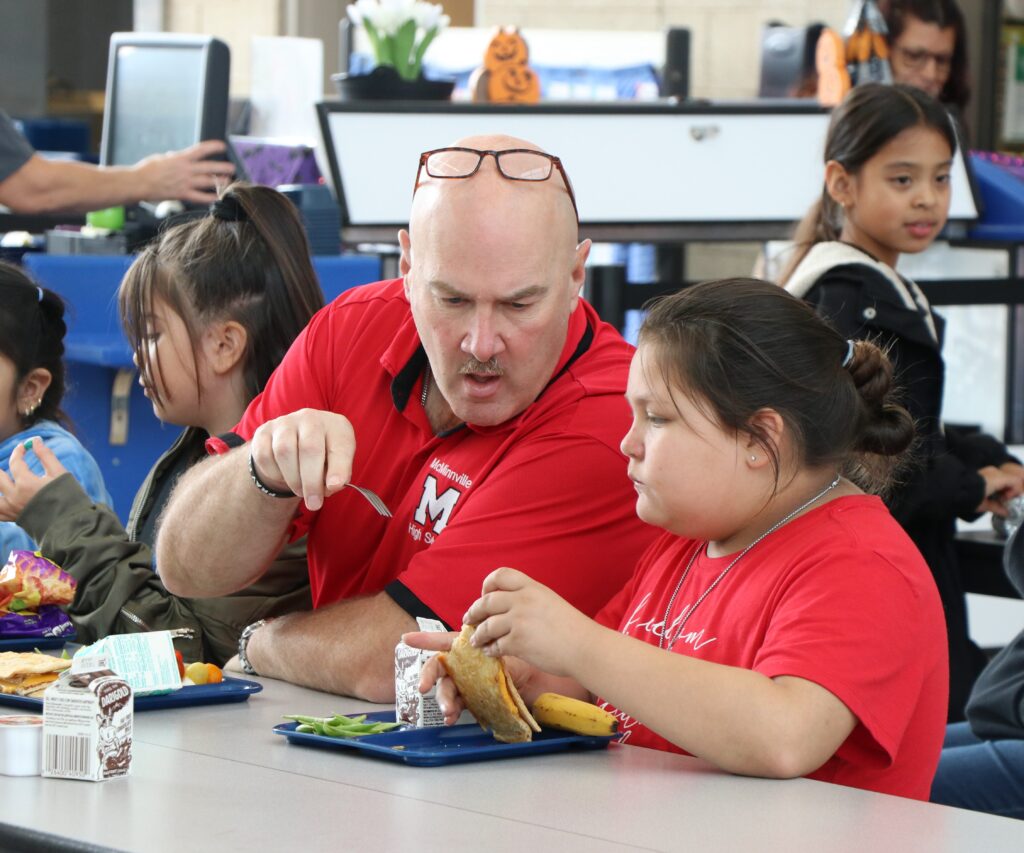
Buel Elementary third grader Bella Gaona (right) got one of the coveted lunch spots Tuesday next to McMinnville School Board member Larry Vollmer. (Photo by Jake Arnold, OSBA)
Third grader Bella Gaona was delighted when McMinnville School Board member Larry Vollmer joined her class for lunch.
“I get to see my best friend,” she said, scrunched up against his shoulder and munching on a turkey panini.
Students with trays piled with cucumbers and pea pods clustered around as Vollmer made them laugh. Vollmer regularly volunteers in Gaona’s Buel Elementary classroom, but a lunch visit is a special event.
McMinnville Nutrition Services Manager Shiloh Ficek said the students were also receiving a stealth nutrition lesson as an adult modeled healthy eating.
National School Lunch Week, Oct. 9-13, is a prime time for school board members to arrange school lunch visits. School board members should reach out to nutrition staff or administrators before visiting so they can prepare and also provide a possible cost for the meal. OSBA and the Oregon Department of Education are encouraging school board members to learn first-hand about meal programs and share their experiences with their communities.
“Good nutrition is a necessary part of a good learning system,” said Sonja McKenzie, OSBA Board president and a Parkrose School Board member. “Oregon schools play a vital role in feeding hundreds of thousands of students every weekday, and for some households provide a main barrier against hunger.”
Ontario Nutrition Services Director Pam Suyematsu said school board members should visit so they can see the meals program and help parents understand.
Suyematsu said limits on time and money affect meal choices, but they do their best to create as many scratch offerings from local sources as possible for thousands of meals a day.
Suyematsu counts among recent successes the development of a large-batch recipe for pozole, a Mexican soup.
“We probably are not going to make it as good as grandma, but as far as school meals go, students think it is pretty terrific,” she said.
McMinnville is trying to move away from processed food as well, with local produce, fresh-baked muffins, and soups and entrees made from scratch. Nutrition Services Supervisor Joanna Duyck said the fresh-made meals have better textures, more appealing aromas and higher nutrition value. Many of the students at a recent lunch period said the fresh-cooked food is their favorite.
“We are trying to get rid of the stigma of school lunches,” Duyck said.
It seems to be working. The district of about 6,300 students southwest of Portland served more than 100,000 meals a month last school year, with breakfasts, lunches and after-school meals. In September, the district served roughly 9,000 more meals, according to Ficek.
That’s a win for students, Ficek and Duyck said. According to the School Nutrition Association, research shows that students who eat meals at school do better academically, miss less school and have fewer behavior problems. School meals, which are prepared under strict federal nutrition guidelines, tend to be more healthy than meals from home, according to the association.
School nutrition programs are also teaching students how to eat better on their own with programs such as the federal Fresh Fruit and Vegetable Program. Under the program, McMinnville nutrition services staff prepare classroom samples of foods such as sweet potato, figs and dragon fruit to introduce students to new tastes.
ODE promotes a variety of programs to help further nutrition education in schools, including the 2024 Oregon Farm to School and School Garden Conference Feb. 15-16 in Corvallis.
Vollmer said school meals have changed since he joined the school board in 2006.
“Back in the day it was just a lunch,” he said. “Now it is so much more intentional.”
Vollmer said school board members need to visit schools to hear and see students’ perspective.
“The work isn’t done in meetings,” he said. “It’s done here in the building.”
The Buel third grade class adopted Vollmer last fall. He regularly volunteers in the classroom and occasionally joins them in the cafeteria and on the playground. The children clamoring around him at lunch said it makes them feel important when adults visit. They all said they now know what a school board member is.
“Someone who comes to see what you are learning and to help you,” said Julianna Juarez.
– Jake Arnold, OSBA
[email protected]